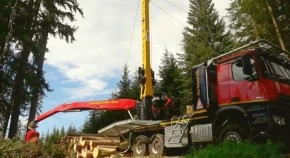
Researchers examined the potential of hybridized drivetrains for tower yarder applications.
Radical changes are necessary to address challenges related to global warming and pollution. Ever-tightening emission standards for combustion engines have already led to a drastic reduction in the amount of harmful gas and matter emitted. Drivetrain hybridization and electrification, which are becoming increasingly popular in all sectors, are two additional ways to achieve that goal. However, within the forestry sector most of the equipment still rely on conventional mechanic or hydraulic drivetrains. An example of this is tower yarders, the workhorse of the alpine logging industry.
This research simulated the duty cycle and energy flow of tower yarders in logging operations, both with conventional diesel–hydraulic configuration and a proposed hybrid configuration. The objective was to determine the potential of hybridized drivetrains for tower yarder applications. Detailed models were developed to describe the cable-based extraction of timber and tower yarder internal processes. Extensive simulations were performed to determine force, power and energy components during the harvesting operation for both the diesel–hydraulic and hybrid drivetrains.
Results confirm the large potential of the hybrid configuration for efficiency improvement and emission reduction, with estimated fuel savings of 45% and 63% in the uphill and downhill configurations, respectively. Extensive sensitivity analysis further demonstrates that the hybrid concept remains effective across a wide range of cable setup and transport characteristics. This confirms the large potential of electrified drivetrains, especially in the presence of very dynamic duty cycles, as is the case in cable-based logging equipment.
This research was titled " Tower yarder powertrain performance simulation analysis: electrification study” and was published in the European Journal of Forest Research. The researchers were Stefan Leitner, Manuel Antonio Perez Estevez, Massimiliano Renzi, Raffaele Spinelli, Fabrizio Mazzetto & Renato Vidoni. Source